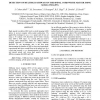Free Online Productivity Tools
i2Speak
i2Symbol
i2OCR
iTex2Img
iWeb2Print
iWeb2Shot
i2Type
iPdf2Split
iPdf2Merge
i2Bopomofo
i2Arabic
i2Style
i2Image
i2PDF
iLatex2Rtf
Sci2ools
ISBI
2008
IEEE
2008
IEEE
Detection of multiple pathways in the spinal cord white matter using q-ball imaging
High angular resolution MRI such as q-ball imaging (QBI) allows to recover complex white matter architecture. We applied this technique to an ex vivo spinal cord of one cat using a 3T scanner, 100 directions and b-values varying from 1000 to 3000 s/mm2 . As a result, QBI can retrieve crossing fibre information, where the diffusion tensor imaging approach is constrained to a single diffusion direction. To our knowledge, this is the first study demonstrating the benefits of QBI in observing longitudinal, commissural and dorso-ventral fibres in the spinal cord. It is a first step towards in vivo characterization of the healthy and injured spinal cord using high angular resolution diffusion imaging (HARDI) and QBI.
Angular Resolution Diffusion | Injured Spinal Cord | ISBI 2008 | Medical Imaging | Vivo Spinal Cord |
| Added | 20 Nov 2009 |
| Updated | 20 Nov 2009 |
| Type | Conference |
| Year | 2008 |
| Where | ISBI |
| Authors | Julien Cohen-Adad, Maxime Descoteaux, Serge Rossignol, Richard D. Hoge, Rachid Deriche, Habib Benali |
Comments (0)

